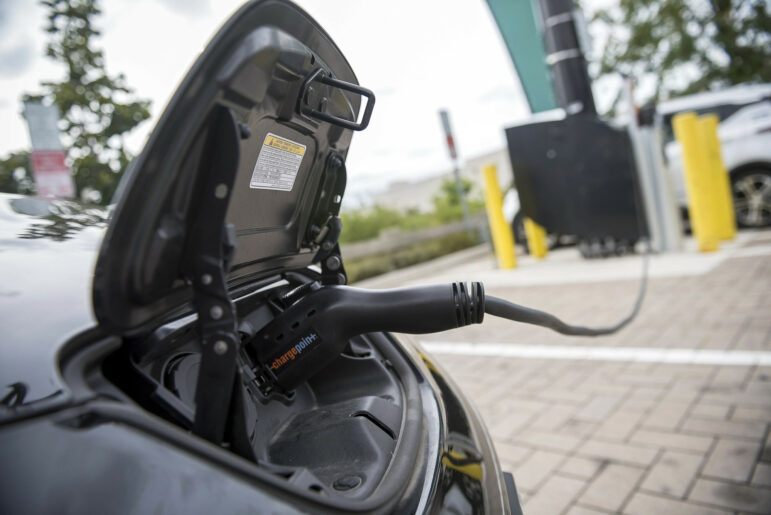“A free pass for Uber, Lyft, and other big corporations to add thousands more inaccessible vehicles to our streets, with drivers footing the bill, is a step in the wrong direction.”

Ed Reed/Mayoral Photography Office
An electric vehicle charging in Brooklyn.On Oct. 19, the Taxi and Limousine Commission (TLC) decided to lift a five-year-old policy limiting the number of for-hire-vehicles (FHVs) licensed for service by companies like Uber, Lyft, Revel, and others in New York City. Now, the TLC will issue an unlimited number of FHV licenses, so long as the new vehicles are either electric or wheelchair accessible—“EVs” and “WAVs.”
The problem is, New York urgently needs vehicles that are both electric and fully wheelchair accessible—and drivers need help paying for these new vehicles. Currently, only a mere 4 percent of the nearly 100,000 FHVs in New York City can accommodate wheelchairs—meaning that people with disabilities typically experience longer waits for a ride and difficulty booking a ride at all through the MTA’s Access-A-Ride service, which contracts with Uber, yellow taxis, and other FHV companies.
While the TLC claims to address this shortage by exempting WAVs from the license cap, the agency’s data suggests that this won’t do nearly enough to close the accessibility gap. During recent years in which the TLC offered exemptions to the cap on new licenses for both WAVs and EVs, the number of EVs in the fleet has been growing far more rapidly.
As newer, cleaner, safer, and cheaper EVs and charging stations begin to replace older, more dangerous, and more polluting gasoline vehicles that will become much costlier to maintain and operate, we fear that riders with disabilities will be left even further behind.
Moreover, in the ‘gig’ economy business model of this industry, drivers are stuck with paying for all maintenance and new vehicle costs, and an unfunded mandate to buy new electric cars would push them deeper into poverty. New York City and State must take a stronger, more proactive approach to incentivize the rapid development and sale of vehicles that are both fully accessible and electric.
The TLC must put out a request for information and competitive proposals to the auto industry, and actively work with automakers to develop wheelchair accessible models that are fully electric and can rapidly be brought to market. This is what the TLC did in 2008, and Nissan responded with the NV200 “Taxi of Tomorrow,” which now comprises a significant portion of the aging yellow taxi fleet.
While electric, fully accessible vehicles don’t yet exist in the United States, models and conversion kits are available in Europe, and New York City and State can create and sustain a robust market for these vehicles in the massive FHV industry.
In addition, New York State must provide significant subsidies to FHV drivers to incentivize and ensure they can afford to purchase and operate these accessible EV models without entering into debilitating personal debt. Existing federal and state tax subsidies for EV purchases will not be enough, since larger wheelchair-accessible models are bound to be more expensive at the outset than the inaccessible EVs currently dominating the market.
The transition to accessible and more climate-friendly vehicles must be funded fairly and equitably through a small surcharge on all inaccessible vehicle trips. For example, a statewide surcharge of just $1 per trip, paralleling an existing surcharge on yellow and green cabs, would level the playing field and generate hundreds of millions of dollars annually that could be dedicated to subsidies and incentive payments at the level necessary to ensure that FHV drivers can purchase and operate accessible EVs at a cost comparable to owning and operating an inaccessible vehicle. This kind of green and accessible transition fund is particularly necessary in the many upstate communities where Uber and Lyft operate zero or very few accessible vehicles, creating major transportation barriers for people with disabilities.
A free pass for Uber, Lyft, and other big corporations to add thousands more inaccessible vehicles to our streets, with drivers footing the bill, is a step in the wrong direction. TLC regulators and state legislators must instead work in concert to develop and scale up a new electric “Taxi of Tomorrow” that gives people with disabilities the reliable and safe transportation they deserve, pays FHV drivers fairly for investing in accessible green vehicles, and makes New York a global leader in addressing climate change and universal accessibility with one smart, bold policy.
Justin Wood is the director of policy at New York Lawyers for the Public Interest, a civil rights organization focusing on disability and environmental justice. David Alexis is the director of community partnerships and a driver at the Drivers Cooperative, a worker-owned for-hire vehicle service in New York City.








